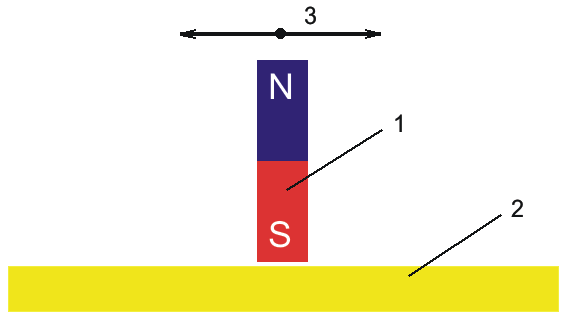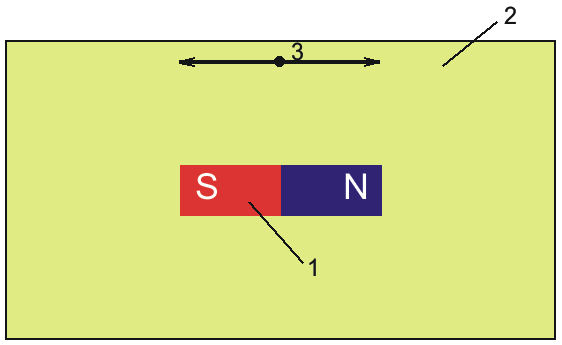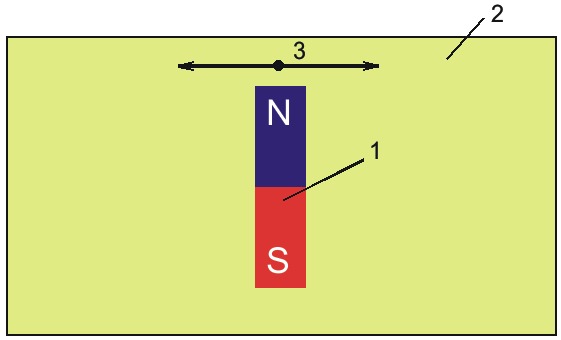|
Alexander A.Shpilman
( alexandrshpilman78@gmail.com ) |
Foucault currents
Very few people in the childhood not to play with constant magnets. Modern
powerful magnets allow to experience are wider a spectrum of
"handing" experiments (for example, the pinched fingers …). For
described it is possible to take advantage of strong constant magnets taken of
old/faulty HDD devices of memory ("Winchesters") of computers more
low. The most difficult possibly now is to find thick sheet of copper or
aluminum. But if mentioned is available, we will make the following experiment:
1) We take a constant magnet (1) in hands and quickly
drive (3) it along a surface of sheet of copper/aluminum (2), focusing to the
last one of magnet poles as it is shown in a Fig.1.
|
Fig.1 |
It is clearly possible to feel arising resistance to
such fast movement.
Now we will start up a magnet in free sliding on a
surface of the inclined thick sheet of copper/aluminum. Sliding of the last is
strongly braked, and even there is an impression that the magnet nestles on
conductor sheet more strongly. Similar experiment - a constant magnet throw in
a vertical pipe from copper or aluminum.
Standard
explanation - magnet movement Foucault's vortical currents brake. But the total
mass electrons involved in vortical movement of many times less mass of a
constant magnet is held back that. And then, what prevents to be displaced to
an electronic whirlwind after a sliding magnet?
It is
logical to assume that "free" electrons, in an electric conductor,
actually are not free. There is a certain grid of electrowire bridges between
atoms of a conductor, on which electrons move. This is grid adheres set of
whirlwinds of currents of Foucault to a crystal lattice. But, experiment with
replacement of continuous sheet of a conductor by sawdust, shows that braking
of movement of a constant magnet becomes imperceptible. I.e. electrowire
"bridges" between atoms of a conductor it not the local phenomenon.
"Bridges" prove in macro-scales.
2) But we will continue experiment with that that is
available for us in hands - quickly we drive (3) a magnet (1) along a surface
of sheet of copper/aluminum (2), focusing to the last already its both poles as
it is shown in a Fig.2.
|
Fig.2 |
Resistance to fast movement as in experiment 1) is
thus felt too.
3) But here if we will turn a magnet and it we will
quickly move, perpendicularly direct between magnet poles (as is shown in a Fig.3)
we any more will not find out resistance to its fast movement.
|
Fig.3 |
Where Foucault's currents have got to?...
Anywhere they have not got to, simply their plane
there was to cross a plane of our sheet of copper/aluminum that has caused
occurrence on a surface of sheet of an electric charge as in the banal unipolar
generator of an electric current. In our case the electric chain has appeared
is not closed, the "vortical" contour is opened … in macro-scales.
That again suggests existence of electrowire "bridges" between atoms
of a conductor in macro-scales.
It is interesting, how these "bridges" will
prove if them to remove for metal limits? We can find out pictures of "a
tractor trace" similar Fig. 2 in " Discovery of magnetic monopole or DSS elements?"?
And Tesla invented to use "bridges" for
creation of gravitational effects of the design of "UFO"?
Conductors moved in a magnetic field and in a design
"Experimental research of dynamic magnetic
system" ( English PDF version )



